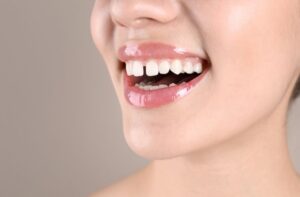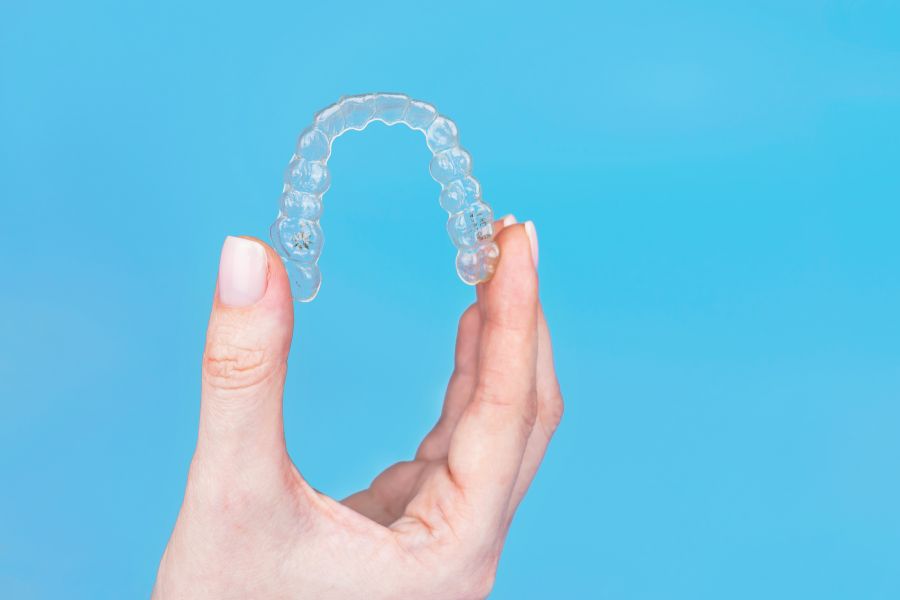Traditional braces consist of metal brackets and wires that are attached to the front of the teeth. The brackets are connected by wires that are tightened over time, gradually shifting the teeth into the desired position. While traditional braces are highly effective at closing teeth gaps, they are also noticeable.
Lingual braces are similar to traditional braces, but they are attached to the back of the teeth instead of the front, making them less noticeable. However, they can be more difficult to clean and maintain than traditional braces.
Clear aligners are one of the most popular options for fixing teeth gaps because they are virtually invisible and offer a more comfortable fit than traditional braces. Clear aligners consist of a series of customized clear plastic trays that are worn over the teeth.
Clear aligners are made of a transparent plastic material, making them virtually invisible, while traditional braces use metal brackets and wires that are much more noticeable. This allows patients to achieve the desired results without feeling self-conscious about their appearance.
Clear aligners are designed to fit comfortably over the teeth, minimizing any discomfort or irritation that may be associated with traditional braces. Unlike traditional braces, clear aligners can be easily removed, making it easier to maintain good oral hygiene habits and enjoy a wider range of foods.
Clear aligners are also an effective solution for teeth gaps because they use a series of customized aligners that gradually shift the teeth into the desired position, closing the gap and improving overall dental alignment. This method allows for greater precision and control, ensuring that the teeth move in the right direction and the desired results are achieved.
In addition to orthodontic treatments, there are several cosmetic procedures available for fixing teeth gaps. These procedures are typically faster than orthodontic treatments and are designed to improve the appearance of the teeth. In this section, we’ll discuss some of the most common cosmetic procedures for teeth gaps.
Dental bonding is a cosmetic procedure that involves applying a tooth-colored resin to the surface of the teeth to fill in gaps and improve their appearance. The resin is hardened using a special light, and then shaped and polished to match the surrounding teeth.
Porcelain veneers are thin, custom-made shells that are bonded to the front of the teeth to improve their appearance. Veneers can be used to cover teeth gaps and create a more even and symmetrical smile. They are durable and long-lasting, but can be more expensive than other cosmetic procedures.
Dental crowns are tooth-shaped caps that are placed over damaged or misshapen teeth to improve their appearance and function. Crowns can also be used to close teeth gaps and improve the overall appearance of the smile. They are durable and long-lasting, but require more extensive preparation than other cosmetic procedures.
In addition to cosmetic and orthodontic treatments, there are also restorative options available for fixing teeth gaps. These options are designed to improve both the appearance and function of the teeth. In this section, we’ll discuss some of the most common restorative options for teeth gaps.
Dental implants are a popular restorative option for teeth gaps caused by missing teeth. The procedure involves placing a titanium post into the jawbone to serve as a replacement tooth root, and then attaching a custom-made crown to the post. Implants look and function like natural teeth, and can last a lifetime with proper care.
Dental bridges are another restorative option for teeth gaps caused by missing teeth. A bridge consists of one or more replacement teeth that are attached to neighboring teeth using dental crowns. Bridges are durable and long-lasting, but require more extensive preparation than other restorative options.
When deciding how to fix your teeth gap, it’s important to consider your individual needs and preferences. Factors such as budget, time frame, and dental health should all be taken into account. It’s also essential to consult with a dental professional to determine the best course of action for your specific case.
After fixing your teeth gap, it’s crucial to maintain your results by following good dental hygiene practices, attending regular dental check-ups, and adhering to any maintenance or cleaning routines recommended by your dentist. This will help ensure the longevity of your treatment and prevent any future dental issues.


